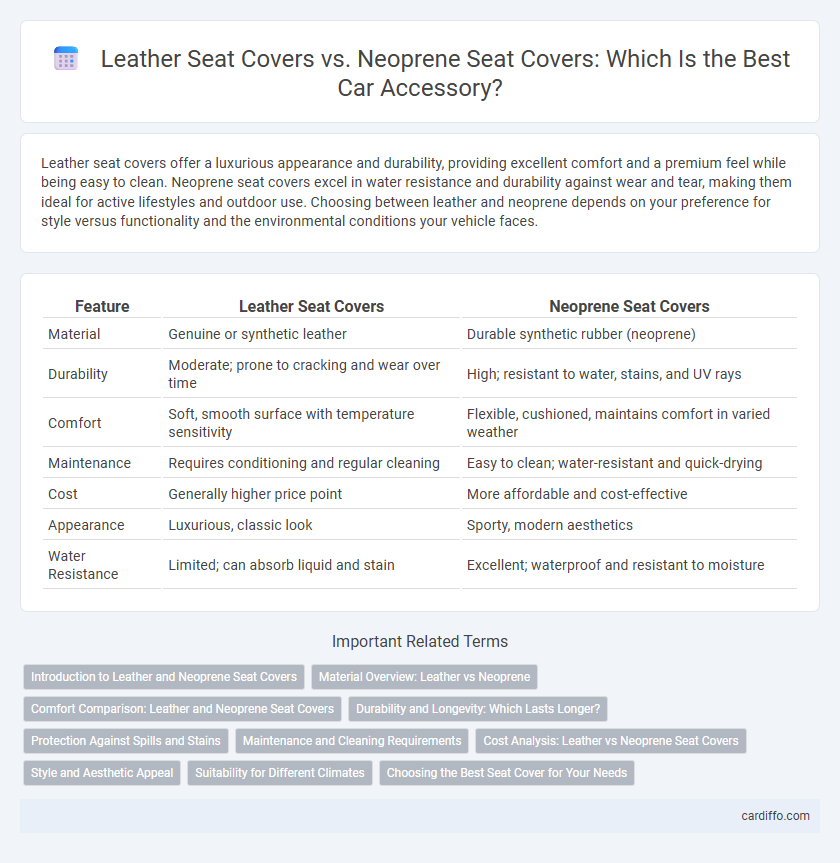Leather seat covers offer a luxurious appearance and durability, providing excellent comfort and a premium feel while being easy to clean. Neoprene seat covers excel in water resistance and durability against wear and tear, making them ideal for active lifestyles and outdoor use. Choosing between leather and neoprene depends on your preference for style versus functionality and the environmental conditions your vehicle faces.
Table of Comparison
| Feature | Leather Seat Covers | Neoprene Seat Covers |
|---|---|---|
| Material | Genuine or synthetic leather | Durable synthetic rubber (neoprene) |
| Durability | Moderate; prone to cracking and wear over time | High; resistant to water, stains, and UV rays |
| Comfort | Soft, smooth surface with temperature sensitivity | Flexible, cushioned, maintains comfort in varied weather |
| Maintenance | Requires conditioning and regular cleaning | Easy to clean; water-resistant and quick-drying |
| Cost | Generally higher price point | More affordable and cost-effective |
| Appearance | Luxurious, classic look | Sporty, modern aesthetics |
| Water Resistance | Limited; can absorb liquid and stain | Excellent; waterproof and resistant to moisture |
Introduction to Leather and Neoprene Seat Covers
Leather seat covers offer a classic, luxurious appearance combined with durability and ease of cleaning, making them a popular choice for high-end vehicles. Neoprene seat covers provide superior water resistance, flexibility, and protection against wear, ideal for active lifestyles and harsh weather conditions. Both materials deliver distinct benefits tailored to varying user needs, from aesthetic appeal to practical functionality.
Material Overview: Leather vs Neoprene
Leather seat covers offer a premium and luxurious feel due to their natural grain, durability, and breathability, making them ideal for comfort and aesthetic appeal in vehicles. Neoprene seat covers provide superior water resistance, flexibility, and resilience against wear, making them suitable for active lifestyles and easy maintenance. Both materials cater to different needs: leather excels in elegance and aging well, while neoprene offers practical protection and long-lasting performance in rugged conditions.
Comfort Comparison: Leather and Neoprene Seat Covers
Leather seat covers offer a luxurious and smooth texture with excellent breathability, enhancing comfort during long drives, while adapting well to temperature changes. Neoprene seat covers provide superior cushioning and water resistance, making them ideal for durability and comfort in wet or active environments. Both materials improve seat protection, but leather excels in style and softness, whereas neoprene prioritizes resilience and moisture control.
Durability and Longevity: Which Lasts Longer?
Leather seat covers offer exceptional durability with resistance to wear and tear, maintaining their appearance over time through proper care. Neoprene seat covers excel in longevity due to their waterproof and UV-resistant properties, which protect against fading, cracking, and moisture damage. While leather provides a classic premium look, neoprene's robust material composition often results in longer-lasting performance in harsh environments.
Protection Against Spills and Stains
Leather seat covers provide a high level of protection against spills and stains due to their non-porous surface, making it easy to wipe off liquids and prevent absorption. Neoprene seat covers offer superior resistance to water, oils, and chemicals because of their dense, waterproof material, ensuring that spills do not penetrate the fabric or damage the seats underneath. Both materials enhance seat durability, but neoprene excels in environments prone to heavy moisture and contamination.
Maintenance and Cleaning Requirements
Leather seat covers require regular conditioning to prevent cracking and maintain suppleness, with cleaning involving mild soap and water or specialized leather cleaners. Neoprene seat covers offer superior durability and water resistance, allowing for easier cleaning with simple soap and water, often being machine washable. Both materials benefit from routine maintenance, but neoprene typically demands less intensive care due to its synthetic, waterproof properties.
Cost Analysis: Leather vs Neoprene Seat Covers
Leather seat covers typically have a higher upfront cost, ranging from $200 to $500, due to the premium material and craftsmanship involved. Neoprene seat covers are more budget-friendly, usually priced between $100 and $250, offering durability and water resistance at a lower expense. Long-term maintenance costs for leather include conditioning and cleaning products, while neoprene covers require minimal upkeep, making them more cost-effective over time.
Style and Aesthetic Appeal
Leather seat covers offer a classic, luxurious appearance with a smooth, polished finish that enhances a vehicle's interior elegance. Neoprene seat covers provide a modern, sporty look with vibrant colors and textures that appeal to active lifestyles while maintaining durability. Both materials can be tailored to fit various design preferences, but leather emphasizes sophistication, whereas neoprene highlights casual functionality and bold style.
Suitability for Different Climates
Leather seat covers offer superior durability and elegance, making them ideal for moderate climates where temperature fluctuations are minimal. Neoprene seat covers provide excellent water resistance and insulation, making them highly suitable for humid, rainy, or cold environments. Choosing between leather and neoprene depends on local climate conditions and the need for moisture protection or temperature regulation.
Choosing the Best Seat Cover for Your Needs
Leather seat covers provide a luxurious, durable option with easy cleaning and a classic aesthetic, ideal for those prioritizing style and comfort. Neoprene seat covers offer superior water resistance, flexibility, and protection against elements, perfect for active lifestyles or vehicles exposed to moisture and dirt. Choosing the best seat cover depends on your daily use, climate conditions, and desired balance between comfort and durability.
Leather seat covers vs neoprene seat covers Infographic

 cardiffo.com
cardiffo.com